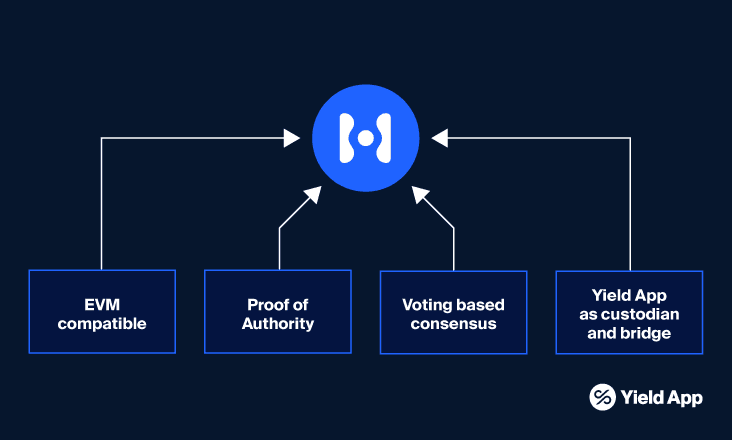The upcoming launch of Haven1 represents a significant progression in technology from the Web2 era, which was dominated with centralized platforms and services. As such, this innovative blockchain is well-positioned to make a significant impact in the digital asset industry, promoting the mainstream adoption of Web3. To achieve this ambitious goal, this innovative blockchain requires a strong tech stack as a foundation.
In this piece, we will delve into the fundamental building blocks that shape Haven1 – the new Layer 1 blockchain incubated by Yield App. Without focusing too closely on the technical details, we aim to provide a high-level overview of all the components that comprise Haven1.
Web3 tech
In the blockchain industry, we distinguish between EVM and non-EVM blockchains. EVM stands for Ethereum Virtual Machine and refers to the underlying software environment created by Ethereum – the second largest blockchain after Bitcoin.
This differentiation is crucial because EVM blockchains, such as Ethereum, enable the deployment of smart contracts. These self-executing agreements are used to build all applications on the blockchain, including lending markets, NFT marketplaces, and even NFTs themselves.
Typically, non-EVM blockchains do not have these capabilities, although some have successfully implemented smart contracts independently. The power of EVM blockchains lies in the fact that each chain runs on similar code, and smart contract developers can easily migrate their work from one EVM blockchain to another.
As such, EVM-compatibility ensures easy onboarding for existing developers who can integrate their prior products seamlessly onto a blockchain. This is the reason why Haven1 is designed as an EVM-compatible network with a distinctive approach to consensus mechanisms and asset custodianship.
From EVM-compatible to Ethereum rollup
Initially, Haven1 will function as a sidechain to Ethereum, similar to how Polygon began its journey. Ethereum was the first blockchain to implement smart contracts which is one of the key reasons for its success over the years.
Haven1 aims to serve as a complementary network to Ethereum. Its ultimate goal is to transition from a side-chain to a rollup that utilizes Ethereum as its settlement layer once rollup technology matures. Once this transition happens, all transactions taking place on Haven1 will be validated by the highly secure node network of Ethereum.
Haven1’s consensus mechanism
The Haven1 blockchain will achieve consensus by working with reputable validator partners in the digital asset industry. The initial validators on Haven1 will be reputable, publicly recognized entities with a demonstrable track record of integrity.
Haven1 will ensure this through legally-binding agreements and anyone using the blockchain will be able to corroborate the validators' identity and track their on-chain performance, further reducing the risk of malicious behavior.
Haven1 also introduces a provable identity framework, with the aim to foster trust between users and validators. Under this framework, certain actions on the blockchain will require users to verify their identity.

Governance rights
Haven1’s voting-based consensus mechanism means the blockchain’s participants (holders of the native H1 token) are responsible for governing key decisions., As such, all crucial network and governance decisions must be ratified by the network validators in complete consensus.
This governance framework will also allow token holders to propose and implement new features and upgrades to the network. For example, they may vote to add new protocols or applications or make changes to existing ones. This allows Haven1 to continuously improve and expand, providing users with a more robust and comprehensive platform for on-chain finance.
Yield App as custodian and secure bridge
Once Haven1 is operational, the Yield App platform will serve as the sole gateway to the chain, acting as a secure bridge to the network. Chainlink provides price feeds which relay prices and other data from off-chain sources to Haven1.
Furthermore, Yield App will partner with an institutional-grade digital asset custody solution to ensure that all user funds are secure and protected – details to be revealed at a later date. Regular proof-of-assets attestations enable anyone to verify this and further ensure complete network transparency.
Conclusion
Haven1’s tech stack is a crucial component of its mission to provide a secure and efficient Web3 platform. As an EVM-compatible blockchain network, Haven1 will be complementary to Ethereum, while utilizing an environmentally-friendly consensus mechanism. Haven1’s partnerships with market-leading projects will further ensure the security of users’ assets at all times.
Haven1's tech stack is an impressive combination of cutting-edge technology, security, and transparency that sets it apart from other blockchain networks. As the industry continues to evolve, Haven1's mission to maintain integrity and provide a secure environment for global participants in on-chain finance will undoubtedly make it a significant player in the blockchain space.
This blog post is part of a six-part series on Haven1. In the previous articles, we covered the need for a more secure blockchain environment (read here) and Haven1's commitment to fulfilling that demand (read here).
DISCLAIMER: The content of this article does not constitute financial advice and is for informational purposes only. The price of digital assets can go down as well as up, and you may lose all of your capital. Investors should consult a professional advisor before making any investment decisions.
 Learn more
Learn more
